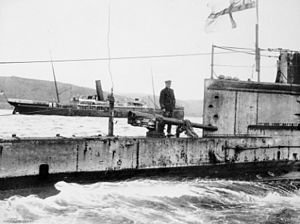HMS E2 (originally ordered as HMS D10) was a British E class submarine built by Chatham Dockyard. E2 was laid down on 14 February 1911 and launched on 23 November 1912.
 Lt-Cmdr D de B Stocks on deck after a mission in the Dardanelles, circa. August 1915
| |
| History | |
|---|---|
| Name | E2 |
| Builder | HM Dockyard, Chatham |
| Laid down | 14 February 1911 |
| Launched | 23 November 1912 |
| Completed | 30 June 1913 |
| Fate | Sold, 7 March 1921 |
| General characteristics | |
| Class and type | E-class submarine |
| Displacement |
|
| Length | 178 ft (54 m) |
| Beam | 15 ft 5 in (4.70 m) |
| Propulsion |
|
| Speed |
|
| Range |
|
| Complement | 31 |
| Armament | 4 × 18-inch (450-mm) torpedo tubes (1 bow, 2 beam, 1 stern) |
She was sold 7 March 1921 to B Zammit, Malta.
Design
editThe early British E-class submarines, from E1 to E8, had a displacement of 652 long tons (662 t) at the surface and 795 long tons (808 t) while submerged. They had a length overall of 180 feet (55 m) and a beam of 22 feet 8.5 inches (6.922 m), and were powered by two 800 horsepower (600 kW) Vickers eight-cylinder two-stroke diesel engines and two 420 horsepower (310 kW) electric motors.[1][2] The class had a maximum surface speed of 16 knots (30 km/h; 18 mph) and a submerged speed of 10 knots (19 km/h; 12 mph), with a fuel capacity of 50 long tons (51 t) of diesel affording a range of 3,225 miles (5,190 km; 2,802 nmi) when travelling at 10 knots (19 km/h; 12 mph), while submerged they had a range of 85 miles (137 km; 74 nmi) at 5 knots (9.3 km/h; 5.8 mph).[1]
The early 'Group 1' E class boats were armed with four 18 inch (450 mm) torpedo tubes, one in the bow, one either side amidships, and one in the stern; a total of eight torpedoes were carried. Group 1 boats were not fitted with a deck gun during construction, but those involved in the Dardanelles campaign had guns mounted forward of the conning tower while at Malta Dockyard.[1]
E-Class submarines had wireless systems with 1 kilowatt (1.3 hp) power ratings; in some submarines, these were later upgraded to 3 kilowatts (4.0 hp) systems by removing a midship torpedo tube. Their maximum design depth was 100 feet (30 m) although in service some reached depths of below 200 feet (61 m). Some submarines contained Fessenden oscillator systems.[3]
Crew
editHer complement was three officers and 28 men.[3]
Service history
editWhen war was declared with Germany on 5 August 1914, E2 was based at Harwich, in the 8th Submarine Flotilla of the Home Fleets.[4]
On 14 August 1915, E2 sank Turkish minelayer Samsun with her two officers and eight crew near Erdek.
References
edit- ^ a b c Akerman, P. (1989). Encyclopaedia of British submarines 1901–1955. p.150. Maritime Books. ISBN 1-904381-05-7
- ^ "E Class". Chatham Submarines. Archived from the original on 13 August 2015. Retrieved 20 August 2015.
- ^ a b Innes McCartney; Tony Bryan (20 February 2013). British Submarines of World War I. Osprey Publishing. pp. 11–12. ISBN 978-1-4728-0035-0.
- ^ Position and Movements, H.M. Ships, War Vessels and Aircraft, British and Foreign, Parts I. and II., August 1914. London: Admiralty Records. 1914.
Bibliography
edit- Colledge, J. J.; Warlow, Ben (2006) [1969]. Ships of the Royal Navy: The Complete Record of all Fighting Ships of the Royal Navy (Rev. ed.). London: Chatham Publishing. ISBN 978-1-86176-281-8.